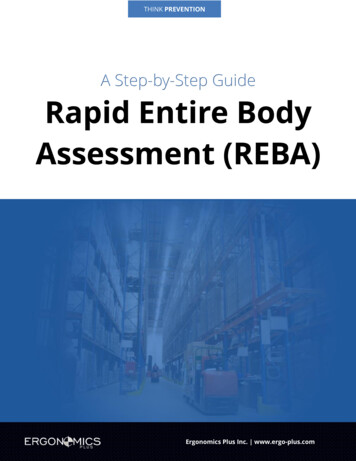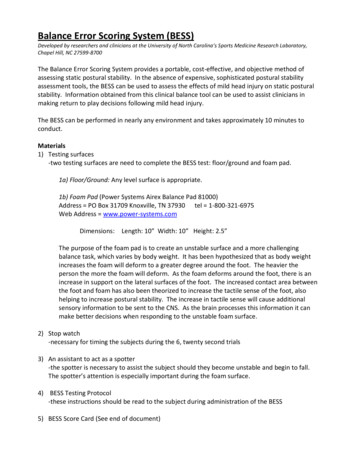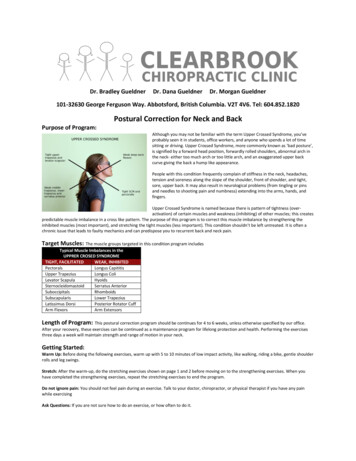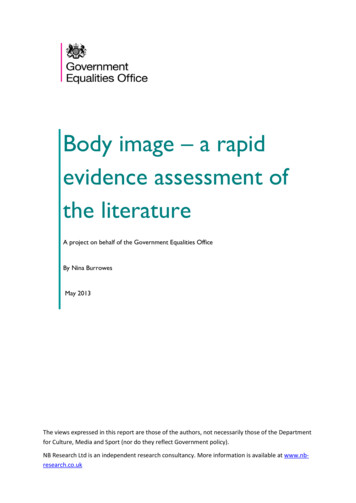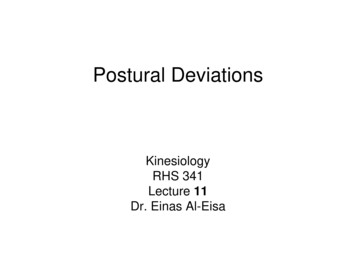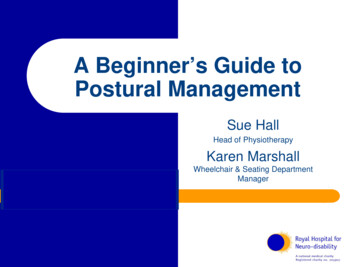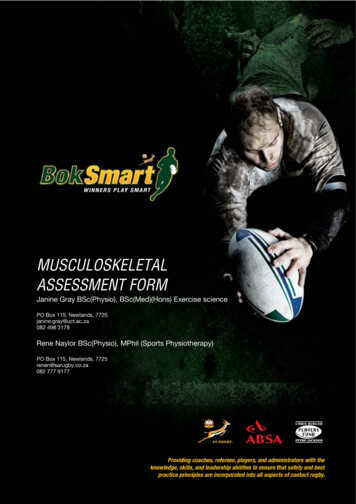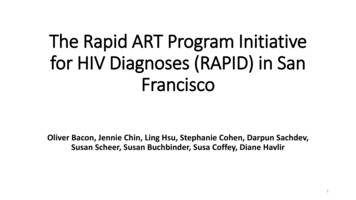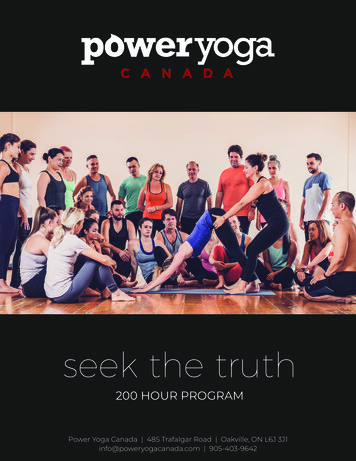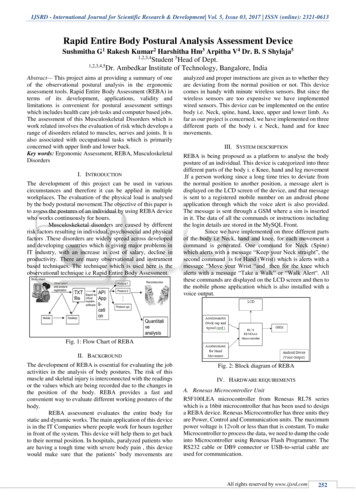
Transcription
IJSRD - International Journal for Scientific Research & Development Vol. 5, Issue 03, 2017 ISSN (online): 2321-0613Rapid Entire Body Postural Analysis Assessment DeviceSushmitha G1 Rakesh Kumar2 Harshitha Hm3 Arpitha V4 Dr. B. S Shylaja51,2,3,4Student 5Head of Dept.1,2,3,4,5Dr. Ambedkar Institute of Technology, Bangalore, IndiaAbstract— This project aims at providing a summary of oneof the observational postural analysis in the ergonomicassessment tools. Rapid Entire Body Assessment (REBA) interms of its development, applications, validity andlimitations is convenient for postural assessment settingswhich includes health care job tasks and computer based jobs.The assessment of this Musculoskeletal Disorders which iswork related involves the evaluation of risk which develops arange of disorders related to muscles, nerves and joints. It isalso associated with occupational tasks which is primarilyconcerned with upper limb and lower back.Key words: Ergonomic Assessment, REBA, MusculoskeletalDisordersI. INTRODUCTIONThe development of this project can be used in variouscircumstances and therefore it can be applied in multipleworkplaces. The evaluation of the physical load is analysedby the body postural movement.The objective of this paper isto assess the postures of an individual by using REBA devicewho works continuously for hours.Musculoskeketal disorders are caused by differentrisk factors resulting in individual, psychosocial and physicalfactors .These disorders are widely spread across developedand developing countries which is giving major problems inIT industry, with an increase in cost of salary, decline inproductivity. There are many observational and instrumentbased techniques. The technique which is used here is theobservational technique i.e Rapid Entire Body Assessment.analyzed and proper instructions are given as to whether theyare deviating from the normal position or not. This devicecomes in handy with minute wireless sensors. But since thewireless sensors are too expensive we have implementedwired sensors. This device can be implemented on the entirebody i.e. Neck, spine, hand, knee, upper and lower limb. Asfar as our project is concerned, we have implemented on threedifferent parts of the body i. e Neck, hand and for kneemovements.III. SYSTEM DESCRIPTIONREBA is being proposed as a platform to analyse the bodyposture of an individual. This device is categorized into threedifferent parts of the body i. e Knee, hand and leg movement.If a person working since a long time tries to deviate fromthe normal position to another position, a message alert isdisplayed on the LCD screen of the device, and that messageis sent to a registered mobile number on an android phoneapplication through which the voice alert is also provided.The message is sent through a GSM where a sim is insertedin it. The data of all the commands or instructions includingthe login details are stored in the MySQL Front.Since we have implemented on three different partsof the body i.e Neck, hand and knee, for each movement acommand is generated. One command for Neck (Spine)which alerts with a message “Keep your Neck straight”, thesecond command is for Hand (Wrist) which is alerts with amessage “Move your Wrist “and then for the knee whichalerts with a message “Take a Walk” or “Walk Alert“. Allthese commands are displayed on the LCD screen and then tothe mobile phone application which is also installed with avoice output.Fig. 1: Flow Chart of REBAII. BACKGROUNDThe development of REBA is essential for evaluating the jobactivities in the analysis of body postures. The risk of thismuscle and skeletal injury is interconnected with the readingsor the values which are being recorded due to the changes inthe position of the body. REBA provides a fast andconvenient way to evaluate different working postures of thebody.REBA assessment evaluates the entire body forstatic and dynamic works. The main application of this deviceis in the IT Companies where people work for hours togetherin front of the system. This device will help them to get backto their normal position. In hospitals, paralyzed patients whoare having a tough time with severe body pain , this devicewould make sure that the patients’ body movements areFig. 2: Block diagram of REBAIV. HARDWARE REQUIREMENTSA. Renesas Microcontroller UnitR5F100LEA microcontroller from Renesas RL78 serieswhich is a 16bit microcontroller that has been used to designa REBA device. Renesas Microcontroller has three units theyare Power, Control and Communication units. The maximumpower voltage is 12volt or less than that is constant. To makeMicrocontroller to process the data, we need to dump the codeinto Microcontroller using Renesas Flash Programmer. TheRS232 cable or DB9 connector or USB-to-serial cable areused for communication.All rights reserved by www.ijsrd.com252
Rapid Entire Body Postural Analysis Assessment Device(IJSRD/Vol. 5/Issue 03/2017/065)Fig. 3: Flow chart of Renesas MicrocontrollerFig 5: Flow chart of GSMFig. 4: 64 pin Renesas microcontroller boardB. Liquid Crystal Display (LCD)LCD (Liquid Crystal Display) is a thin, flat display devicemade up of any number of color or monochrome pixelsarrayed in front of a light source or reflector. Liquid crystallayer is inserted between two electrodes. It is used as a userinterface. It has 14 pins, out of which 3 pins are controllingpins and 2 others are Vcc and Ground. Port 7 ofmicrocontroller is used for LCD. It is used to display thechanges in output voltages of accelerometer and any eventoccurring. It can take 16 characters which will be displayedin two lines and rest of them are truncated.D. AccelerometerAccelerometers are mounted on Neck cap (which covers theentire spine), hand and on knee. The output of theseaccelerometers are given to the ADC unit of themicrocontroller. Once the sensors detect the movement of thebody, the readings in the analog form are noted and convertedto the digital form which is displayed on the LCD. Thevoltages generated by the accelerometer are based on theprogram embedded within the microcontroller are displayed.If the person wearing this device is sitting for a longtime, a voice output will be generated until the person returnsto the normal position.E. Android DeviceEclipse Kepler, a software used to create and generateapplications on our android device. The code is written inJava programming language. Once the application is created,a login form appears on the screen where the registration hasto be done.On receiving information sent by GSM module, avoice output is generated from the android device using theapplication created.V. TECHNOLOGY USEDA. Eclipse V10Fig. 4: Circuit Diagram of LCDC. Global System for Mobile Communication (GSM)GSM (Global System for Mobile Communication) isdeveloped as a digital system using TDMA (Time DivisionMultiple Access) technology. GSM model can accept anyGSM network operator SIM (Subscriber Identity Module).By this we receive the message from the REBA device and issent to the mobile phone application. GSM is the mostpopular standard for mobile phones in the world. The GSMstandard has been of greater advantage to both clients andalso to network engineers. GSM networks operate ondifferent carrier frequencies which ranges with most of the2G GSM networks operating between 900 MHz and1800 MHz bands.Fig. 6: Eclipse V10The Integrated Development Environment (IDE) which wehave used here is Eclipse Kepler. This is used to create anAndroid Application. The application that we have designedis REBA.B. MySQLFig. 7: MySQLAll rights reserved by www.ijsrd.com253
Rapid Entire Body Postural Analysis Assessment Device(IJSRD/Vol. 5/Issue 03/2017/065)MySQL is the open source relational SQL databasemanagementC. JavaFig. 8: JavaJava being high level programming language is portableacross operating systems. Reliability and accessibility are itsadvantages. It converts source code into byte code. Java is aclass based, structured programming following the multipleparadigm. Java language is secure and it is robust.D. Cube Suite Integrated Development Environment Cube Suite offers theultimate in simplicity, usability and security for the repetitiveediting, building and debugging that typifies softwaredevelopment.Fig. 9: Renesas Flash ProgrammerIt is highly user-friendly development environmentfeaturing significantly shorter build times and graphicaldebug function.E. Renesas Flash ProgrammerFig. 11: ImplementationIf there is a deviation from the normal position of thewrist i,e 190 ,message is displayed on the LCD as well as avoice output is generated through the android device.Fig. 12: ImplementationIf there is a deviation from the normal position of theleg i,e 160 and count 30 ,message is displayed on the LCDas well as a voice output is generated through the androiddevice.Fig. 13: ImplementationAll these messages that are sent via GSM to themobile phone application with user details are stored inMySQL Front (Web Services). We can create as many usersas possible. Here, we are making use of one registerednumber, because the registered number in the code is dumpedto the microcontroller using the software Renesas FlashProgrammer via DB9 connector.VII. SNAPSHOTSFig. 10: Renesas Flash ProgrammerRenesas Flash Programmer is software that erases, writes,and verifies program on the target system or program adapteron which a Renesas Electronics single-chip microcontrollerwith on-chip flash memory is mounted. Writing is controlledby the host machine and Graphical User Interface (GUI)specific to writing.VI. IMPLEMENTATIONImplementation include registration page, user or login page.Initially we insert the sim in the GSM sim slot and check ifthe sim is activated by the message being displayed on theLCD. Soon after the GSM is activated, the initial readings aredisplayed on the LCD display. The normal postural readingsthat are recorded initially are displayed (180 190 160 0-30).Now the sensors are fixed on the neck, wrist and the knee withproper positions respectively. The first reading on the displayis for the neck, second is for wrist, third is for knee and thelast reading is a count for the knee (initially we have 30counts), after it crosses 30, it will prompt a message “Take aWalk”. If there is a deviation from the normal position of theneck i.e 180, message is displayed on the LCD as well as avoice output is generated through the android device.Fig. 14: Snapshots of circuitA. REBAFig. 15: REBAAll rights reserved by www.ijsrd.com254
Rapid Entire Body Postural Analysis Assessment Device(IJSRD/Vol. 5/Issue 03/2017/065)B. Initial DisplayVIII. CONCLUSION AND FUTURE ENHANCEMENTToday we have implemented our device REBA working forpeople in IT industries, factories, hospitals, warehouses, andlaboratories. In this project, we have developed a devicewhich helps people to overcome their health related issues.As a future enhancement, we are making use of the sameproject being implemented for the wireless sensors replacingwired sensors. This device is likely to boost the country’seconomy in the future days. These type of wireless sensorsenable a larger group of people to wok comfortably withoutany health hazards even in complex environmentcontinuously. This device could also be a boon in reducingthe risk factors leading to musculoskeletal disorders resultingin a healthier workplace.Fig. 16: Initial DisplayC. Registration PageACKNOWLEDGEMENTWe would like to convey our sincere gratitude to our collegeDr. Ambedkar Institute of Technology for providing us aplatform and a wonderful opportunity where we couldshowcase our technical skills. Firstly, we would like to thankour Honorable Principal Dr. Nanjundaswamy and the DeanMr. T. N. Manjunath for encouraging students to come withan innovative projects of their own. We are very grateful toDr. B.S. Shylaja, Professor and HOD of the department ofInformation Science and Engineering for her support to takeup this project and who also happens to be our project guideleading to the completion of the project successfully.REFERENCESFig. 17: Registration pageD. Main ScreenFig. 18: Login PageFig. 19: Successful Registration Screen[1] Chiasson, M., D. Imbeau, K. Aubry and A. Delisle,2012. Comparing the results of eight methods etal disorders. Int. J. Indust. Ergonom.,42: 478-488. DOI: 10.1016/j.ergon.2012.07.003.[2] Coyle, A., 2005. Comparison of the rapid entire bodyassessment and the New Zealand manual handling‘hazard control record’, for assessment of manualhandling hazards in the supermarket industry. Work,24: 111-116.[3] David, G., 2005. Ergonomic methods for loskeletal disorders. Occupat. Med., 55:190-199. DOI: 10.1093/occmed/kqi082.[4] Gentzler, M. and S. Stader, 2010. Posture stress onfirefighters and Emergency Medical Technicians(EMTs) associated with repetitive reaching, bending,lifting and pulling tasks. Work, 37: 227-239. DOI:10.1371/journal.pone.0091215.[5] Hashim, A., S. Dawal and N. Yusoff, 2012. Ergonomicevaluation of postural stress in school workshop. Work,41: 827-831. DOI: 10.3233/WOR-2012-0249-827.[6] De Sa, F., M. De Nascimento, A. De Melo, J. Santos andP. Adissi, 2006. Comparison of methods RULA andREBA for evaluation of postural stress in odontologicalservices. Proceedings of the 3rd Conference onProduction Research-Americas' Region (ICPR-AM’ 06).[7] Hignett, S. and L. McAtamney, 2000. Rapid Entire BodyAssessment (REBA). Applied Ergonom., 31: 201205.DOI:10.1016/S0003-6870(99)00039-3[8] Janowitz, I., M. Gillen, G. Ryan, D. Rempel and LTrupin et al., 2006. Measuring the physical demands ofAll rights reserved by www.ijsrd.com255
Rapid Entire Body Postural Analysis Assessment Device(IJSRD/Vol. 5/Issue 03/2017/065)work in hospital settings: Design and implementation ofan ergonomics assessment. Applied Ergonom.,37: 641658. DOI: 10.1016/j.apergo.2005.08.004[9] Jones, T. and S. Kumar, 2007. Comparison of ergonomicrisk assessments in a repetitive high-risk sawmilloccupation: Saw-filer. Int. J. Indust. Ergonom., 37: 744753. DOI: 10.1016/j.ergon.2007.05.005[10] Jones, T. and S. Kumar, 2010. Comparison ofergonomicrisk assessment output in four sawmill jobs.Int. J.Occupat. Safety Ergonom., 16: 105-111.DOI: 10.1080/10803548.2010.11076834.[11] Joseph, C., D. Imbeau and L. Nastasia, 2011.Measurement consistency among observational jobanalysis methods during an intervention study. Int. J.Occupat. Safety Ergonom., 17: 139-146. DOI:10.1080/10803548.2011.11076884[12] Kee, D. and W. Karwowski, 2007. A comparison ofthree observational techniques for assessing posturalloads in industry. Int. J. Occupat. Safety Ergonom.13: 3-14. DOI: 10.1080/10803548.2007.11076704[13] Lasota, A., 2014. A REBA-based analysis of packersworkload: A case study. Scientific J. Logist., 10:87-95.[14] McAtamney, L. and N.E. Corlett, 1993. RULA: Asurvey method for the investigation of work-relatedupper limb disorders. Applied Ergonom., 24: 91-99.DOI: 10.1016/0003-6870(93)90080-S[15] Pillastrini, P., R. Mungnai, C. Farneti, L. Bertozzi andR.Bonfiglioli et al., 2007. Evaluation of two preventiveinterventions for reducing musculoskeletal complaints inoperators of video display terminals. Phys. Therapy, 87:536-544. DOI: 10.2522/ptj.20060092[16] Shanahan, C., P. Vi, E. Salas, V. Reider andL. Hochman et al., 2013. A comparison of RULA,REBA and Strain Index to four psychophysicalscales in the assessment of non-fixed work. Work,45: 367-378. DOI: 10.3233/WOR-121540[17] Stanton, N., A. Hedge, K. Brookhuis, E. Salas and H.Hendrick, 2004. Handbook of Human Factors andErgonomics Methods. 1st Edn., CRC Press,ISBN-10: 0203489926, pp: 768.All rights reserved by www.ijsrd.com256
Rapid Entire Body Postural Analysis Assessment Device Sushmitha G1 Rakesh Kumar2 Harshitha Hm3 Arpitha V4 Dr. B. S Shylaja5 1,2,3,4Student 5Head of Dept. 1,2,3,4,5Dr. Ambedkar Institute of Technology, Bangalore, India Abstract—This project aims at providing a summary of one of the observat
